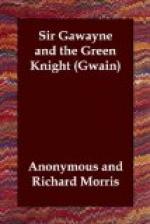PREFACE TO THE FIRST EDITION.
In re-editing the present romance-poem I have been saved all labour of transcription by using the very accurate text contained in Sir F. Madden’s “Syr Gawayne.”
I have not only read his copy with the manuscript, but also the proof-sheets as they came to hand, hoping by this means to give the reader a text free from any errors of transcription.
The present edition differs from that of the earlier one in having the contractions of the manuscript expanded and side-notes added to the text to enable the reader to follow with some degree of ease the author’s pleasant narrative of Sir Gawayne’s adventures.
The Glossary is taken from Sir F. Madden’s “Syr Gawayne,"[1] to which, for the better interpretation of the text, I have made several additions, and have, moreover, glossed nearly all the words previously left unexplained.
For a description of the Manuscript, and particulars relating to the authorship and dialect of the present work, the reader is referred to the preface to Early English Alliterative Poems.
R.M.
London,
December 22, 1864.
[Footnote 1: Sir F. Madden has most
generously placed at the disposal of
the Early English Text Society any of
his works which it may determine to
re-edit.]
* * * * *
Introduction.
No Knight of the Round Table has been so highly honoured by the old Romance-writers as Sir Gawayne, the son of Loth, and nephew to the renowned Arthur. They delighted to describe him as Gawayne the good, a man matchless on mould, the most gracious that under God lived, the hardiest of hand, the most fortunate in arms, and the most polite in hall, whose knowledge, knighthood, kindly works, doings, doughtiness, and deeds of arms were known in all lands.
When Arthur beheld the dead body of his kinsman lying on the ground bathed in blood, he is said to have exclaimed, “O righteous God, this blood were worthy to be preserved and enshrined in gold!” Our author, too, loves to speak of his hero in similar terms of praise, calling him the knight faultless in his five wits, void of every offence, and adorned with every earthly virtue. He represents him as one whose trust was in the five wounds, and in whom the five virtues which distinguished the true knight were more firmly established than in any other on earth.
The author of the present story, who, as we know from his religious poems, had an utter horror of moral impurity, could have chosen no better subject for a romance in which amusement and moral instruction were to be combined. In the following tale he shows how the true knight, though tempted sorely not once alone, but twice, nay thrice, breaks not his vow of chastity, but turns aside the tempter’s shafts with the shield of purity and arm of faith, and so passes scatheless through the perilous defile of trial and opportunity seeming safe.




